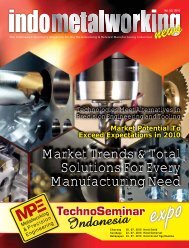High Speed Machining Precision Tooling - Indobiz.biz
High Speed Machining Precision Tooling - Indobiz.biz
High Speed Machining Precision Tooling - Indobiz.biz
You also want an ePaper? Increase the reach of your titles
YUMPU automatically turns print PDFs into web optimized ePapers that Google loves.
automating a broken process. This, in<br />
turn, can lead to increased rework and<br />
scrap.<br />
If you currently rely on your welding<br />
operators to compensate for fi t-up<br />
issues, you will need to look upstream<br />
in the manufacturing process to ensure<br />
consistency. What processes will need<br />
to change to make sure uniform parts<br />
are sent downstream by these welding<br />
operators? Or, if vendors supply the<br />
components, can they guarantee that<br />
consistency?<br />
or reworking parts, and minimize or<br />
eliminate spatter, which in turn reduces<br />
the need to apply anti-spatter or perform<br />
post-weld clean up - both labor-intensive<br />
processes. This means personnel that<br />
currently apply anti-spatter may be<br />
freed up for other, more productive uses<br />
elsewhere.<br />
An automated system can reduce<br />
over-welding, a common and costly<br />
occurrence associated with the semiautomatic<br />
process. For example,<br />
welding operators who weld a bead that<br />
is 1/8 in too large on every pass can<br />
potentially double the cost of welding<br />
(both for labor and for fi ller metals), and<br />
over-welding may adversely affect the<br />
integrity of the part. Automation can<br />
prevent this problem.<br />
REPEAT THAT?<br />
One of the initial things to ask when<br />
considering welding automation is:<br />
“Do we have a blueprint, preferably an<br />
electronic blueprint, of our parts?” If<br />
not, you probably won’t meet the basic<br />
criterion necessary to ensure the part is<br />
repeatable - and repeatability is the key<br />
to automation.<br />
An automated system, whether robotic<br />
or fi xed, must weld in the same place<br />
every time. If a part’s design is unable<br />
to hold its tolerances - if there are gap<br />
and/or fi t-up issues - you will simply be<br />
ROBOTICS OR FIXED AUTOMATION?<br />
No single automation solution is best<br />
for every company. The best solution<br />
depends on many factors, including the<br />
expected lifetime of the job, the cost<br />
of tooling involved and the fl exibility<br />
offered<br />
Fixed automation is the most effi cient<br />
and cost-effective way to weld certain<br />
components, such as those requiring<br />
simple repetitive straight welds or round<br />
welds, where the part is rotated on a<br />
lathe. If you want to redeploy the asset<br />
when the current job ends, however,<br />
a robotic welding system offers more<br />
fl exibility. A robot can also hold programs<br />
Finally, robots are fast. They don’t have<br />
to weld all day to be profi table; they must<br />
only weld more quickly than a manual<br />
welding operator - and they do. This fact<br />
alone increases productivity. Creating<br />
the same number of parts in a shorter<br />
time also decreases labor costs and<br />
raises profi tability. While these benefi ts<br />
may immediately beg the question “How<br />
can our company automate?” a few<br />
questions must be answered fi rst.<br />
indometalworking news Vol. 2 / 2008 29




